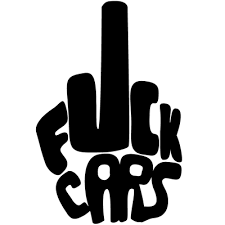Found here: https://twitter.com/CarsRuinedCity/status/1677005785862406144?t=Xolo43mUk4GnegFQE19q3g&s=19
Caption: Photo collage of a beach in Alexandria, Egypt, showing a progression in 3 images:
- Alexandria “Problem” - empty beach + walking street + 6 lane road with medium traffic + dense mid-rise buildings (likely housing)
- Alexandria “Solution” - empty beach (doesn’t seem to matter) + narrower walkway or sidewalk + 10 lane brand new and empty road + tiny sidewalk + the same buildings
- Alexandria “Results” - crowded beach + crowded beach walkway + traffic jam on the 10 lane road
Just one more lane bro I swear we’re gonna fix traffic
Come on bro just one more there’s just not enough room for people to pass bro merging makes things tough bro just one more lane please
It’s hard to stop once you start doing lanes man.
95% of city planners quit before adding the final lane that fixes traffic
The real problem here is that Egyptian cities are grotesquely overpopulated. Cairo is the poster child for urban hell.
if they’re overpopulated, shouldn’t they focus on higher-capacity transportation options?
They absolutely should, however as with most people in power they use cars and therefore see only the traffic jams. And of course everyone knows the best solution to traffic is just building one more lane.
just one more lane bro that’s going to fix it for good
I don’t understand how the middle and right pictures compare. There are ten total lanes in the middle picture, but only six in the right picture.
The whole comparison is stupid without time and date stamps. First looks like it’s an early morning before most people are out and about. Third looks like there’s an event at the beach. Second is strange, maybe the road was just completed or shut down or the cars were edited out.
The right-side pic only shows one direction. There’s a middle separator and another set of lanes in the other direction (not visible). I think this is the area: https://www.google.com/maps/@31.2207203,29.9301834,3a,75y,224.65h,97.18t/data=!3m6!1e1!3m4!1sAF1QipMJJwta1iFu8TyB9UUb6xVX6fjj30Ph2Z0UGKs!2e10!7i5760!8i2880?entry=ttu feel free to look around, I’m not sure how up to date the photos are.
Playing factorio has given me a deeper appreciation of how much adding lanes doesn’t help traffic.
Adding an extra conveyor belt to your factory line won’t help you process materials any faster. You have to add more processing elements, widening the belt lines does absolutely nothing!
Why’s there no one on the beach in the “problem” pic? Kinda seems like one was taken in the slow season and the other was taken in peak rush hour of the busy season.
Completely agree, that’s something I noticed as well. Seems like an apples-to-oranges comparison.
Does it matter? It didn’t solve traffic so adding the lanes did nothing
Yeah, I think it matters. I don’t think inaccurate memes as a form of propaganda are acceptable regardless of whether or not I agree with the original topic. There are plenty of stats, studies, and examples that show the benefits of walkable cities and public transportation. This meme shows a not so busy road and a very busy road with more lanes, the only thing that can be inferred from it is that the pictures were taken on different days, nothing else.
Please don’t say the F word around me; I need to sleep tonight :')
City Skylines is where i learned plentiful with so much fun. Soon City Skylines 2 will be released with even more enhancement/ improvements.
Does learning from games like city skylines make you infuriated when you see real life examples of poor layouts and planning?
I cant wait to buy every single feature as an overpriced dlc.
There’s a few good mini-documentaries on YouTube starting from 1950s America through to now and how the USA is a robust, evidence-rich, long-term case study of why this is bad infrastructure. It’s basically a modern no-brainer now. Thanks to the US we know not to do this. US cities are now slowly trying to undo decades of deep-rooted bad infrastructure choices based around reliance on big road networks.
Surprise, surprise, car manufacturers were a big player in influencing the initial decision 🤣
Having lived in metro areas that have worked on alternative transport solutions, I can tell you it’s sooo much better and easier to live with. And I love cars—own three. But they’re just not the convenient option quite often.
Could you please share the link or the name of the documentary?
I would suggest starting with the Strong Towns playlist from Not Just Bikes: https://youtube.com/playlist?list=PLJp5q-R0lZ0_FCUbeVWK6OGLN69ehUTVa
I’d love for my car to be the inconvenient option but we’re just miles and miles away from that. Sure I could take the metro, it’d cost me more and I’d still need the car to drive to the metro station. Add an hour or so to what any given journey would have taken by car, throw in a handful of sweaty, rude and aggressive co-travelers and you have the answer as to why I drive everywhere.
Yeah, but thats exactly the problem. We know stuff like that is bad, but American cities were built so fundamentally flawed, that we cannot fix the car dependency without completely rebuilding them, which is obviously not an option
Yeah, that’s the poor infrastructure summarised right there. There are minimal alternatives and they’re shit ones. It forces the car to be the only choice, which is fucked if the roads are fucked because there’s no other option to go with.
Mh… there is still some beach left where you can add even more lanes!
This will definitely solve the problem!Yeah, ten is just unlucky, it’s obvious it will not work…
Wonder how bad the noise level is on that beach. Must have to shout to be heard “IT’S REALLY RELAXING HERE!” “What?!”
Good God I can’t wait to move to a country that has public transit
Where are you thinking? I visited London recently and while the underground is cool and efficient, it has quite a depressing atmosphere. I’m wondering how it can be done better
Try Berlin. It’s barrier free. All those bloody barriers you gotta stick your ticket through suck and lead to big traffic jams. Everyone basically has to pay for the upkeep of those things too. Seems like it would be expensive and I definitely hate the shuffle you get in when it’s busy.
Berlin also has it’s problems though. Just different ones.
London is awful. Old trains, super expensive, unreliable service. My subway to the airport was delayed by 25 minutes a month ago with no warning or clear idea when it was going to arrive. Thankfully I had some time before my flight otherwise it would have been a disaster.
Virtually every country does it better other than the US. Paris is amazing. Very cheap, beautifully designed stations, very efficient. Trains are meh but they’re fine.
Japan is a bit weird for having multiple private companies operate subways in the same city, but the reliability and quality is pretty amazing.
I’m actually thinking China. May not be the best country, but it’s easy to get a visa and it’s leagues better than the US.
I like to explain this phenomenon as the free cake effect.
Say you set up a food stand with a sign “free cake”. It doesn’t matter how many cakes you baked, people will keep showing up until all the cake is gone.
and the science gets done and you make a neat gun for the people who are
still alive
So… they’re prepping it for their formula one application?
That was exactly my first thought!
This is one of those arguments that never made sense to me. People like to say that adding lanes just creates more traffic, but what is the proposed mechanism? Does anyone suppose that people who didn’t want to go somewhere suddenly remembered that the highway added more lanes, and then decided to go for a cruise?
It suggests to me that the demand for transit far exceeds capacity, or that this traffic would otherwise have just taken a different route. Probably some of both.
That’s not an argument to just build 15 lane highways everywhere, just that the common form of the supply creates demand argument seems implausible.
If you’re looking for a job and you see an opening but it’s going to take you more than an hour each way to get to and from work, doesn’t that make that job less desirable than jobs that are closer by?
Conversely if you’re looking for a new place to live aren’t you going to consider places that are closer to work to be more desirable?
Suddenly there’s road expansion and a house that used to be 2 hours drive away is now 30 minutes drive from you. So you buy the house.
This would all work out great if you were the only one that thought this. But unfortunately there are many many more people that will also get a house or find a job that’s further way, because it’s only a 30 minutes drive now. So now more people are using the highway and that 10 lane highway is clogged, and that commute time starts going back up. But now you have a mortgage now and so you’re stuck. Everyday in your car for more than an hour each way again.
Cars are simply an inefficient way to move a lot of people. A highway expansion only temporarily solves the problem, but when the highways work well, more people use it and those inefficiencies rear their ugly head again.
Even if the same number of cars are on the road, it is likely that the bottleneck is somewhere else in the city, so adding 20 lanes won’t help the issue anyway.
This like complaining the bathroom is clogged and your solution is to make the showerhead bigger.
Induced demand kinda follows the same psychological patterns as the rebound effect. Latter is easier to understand however.
https://en.m.wikipedia.org/wiki/Rebound_effect_(conservation)
That actually does help, I think, for better grasping the concept! Also…
In order to avoid the rebound effect, environmental economists have suggested that any cost savings from efficiency gains be taxed in order to keep the cost of use the same.[7]
Found that tidbit interesting. The concept of removing the cost savings to insulate efficiency gains against the rebound effect is interesting yet weirdly logical
The idea behind induced demand is the easier and more convenient/cheaper you make a method of transit the more people will use it. So if you make driving easier by building a super highway people will default to that whole if you build put a rail network that gets peole to where they need to go they’ll take that. Transit being crowded in some ways is a good thing as it shows the route you’ve got is good but could prbsky do with a capacity upgrade. Of course roads being crowded is bad due to massive space inefficiencies and environmental issues.
I love it when other countries copy the worst parts of America
When I went to Egypt they were driving crazy there like bumper cars
I taught someone from Egypt how to drive here in the UK. She would absolutely attest to this 😂 She’d tell me that when she drove in Egypt it was a case of having faith in God getting you to your destination. She also said God must have gotten sick of driving for her so He provided her a good instructor 🥰
Edit: I also just realised where I’m posting! Being an instructor, I guess I’m the devil incarnate in this community 👀
Don’t worry, the title says f* cars, not car instructors ;-)
Looking forward to the Lemmy post in 60 years when this is restored
!remindMe 60 years.
Oh wait, no, we don’t that that here, do we.
@remindme@mstdn.social 50 years
widening roads increases traffic. always.
Well yes, but no.
An infinity wide road has no traffic, but the first time you try to connect your magic highway to real exits and local streets, you are stuck again.
By this I’m pointing out that it isn’t the road itself causing traffic in isolation, it’s the real world bottle necks anywhere this new highway connects to things.
Add in induced demand (people taking new trips) and now you have more people trying to fit down the same offramps, local streets and parking lots than you did in the first place.
all you’ve illustrated is that the only place my statement doesn’t apply is in a theoretical (and impossible) fantasy, but you do then go on to explain the means by which what I said is true.
so… thanks?
It’s a conversation bro. We agree about some parts and have other thoughts about other parts.
It’s not the width of the highway that CAUSES the traffic alone, it’s the bottlenecks and access. It’s not the induced demand alone that causes the issue, it’s the offramps and local streets that ruin the new highway.
It’s not the width of the highway that CAUSES the traffic alone, it’s the bottlenecks and access. It’s not the induced demand alone that causes the issue, it’s the offramps and local streets that ruin the new highway.
I’m pretty sure I thanked you explaining how my initial statement was correct.
It’s a conversation bro. We agree about some parts and have other thoughts about other parts.
and I’m enjoying the conversation, bro. your “other” thoughts seem to be an explanation of how my statement is correct and why.
Ok
An infinitely wide road couldn’t be effective unless it was also infinitely long. Cars enter and edit at one edge, and transferring lanes reduces capacity, so adding lanes had diminishing returns.
Indeed, but the width of the highways doesn’t create that effect, the logic surrounding “exits at the edge” does. Totally agree with the diminishing returns
More capacity on the roads will make driving a more attractive option to more people, both for journeys they previously made by other means and those that they wouldn’t have taken, which leads to more cars on the roads until the congestion is as bad as it was before.
I’m aware of induced demand, but the issue with more drivers simply isn’t them inhabiting the new lane, it’s the increased population of the highway still trying to use the same offramps, local streets and parking.
It’s both.














